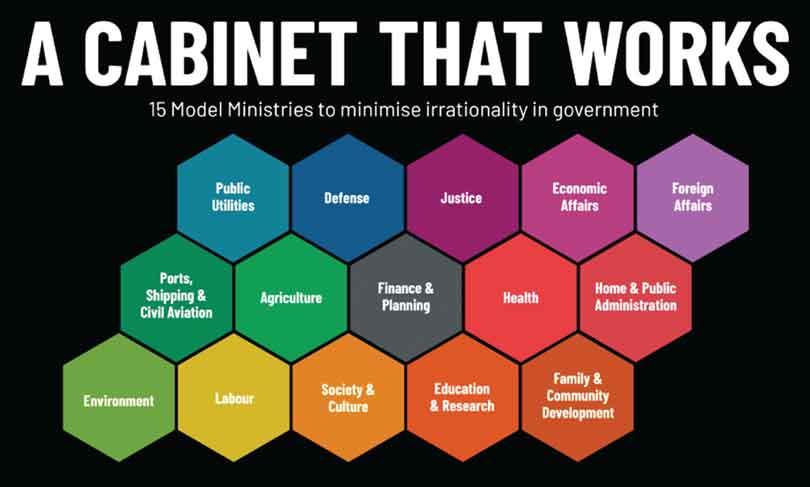Reply To:
Name - Reply Comment

A white paper by Verité Research identifies three ways the design of government fails to be rational, i.e. by constructing the Cabinet ministries and assignments to have high levels of (1) Misalignment (2) Fragmentation and (3) Instability
 Over the past 50 years or so, every Sri Lankan president has followed a non-rational approach to the formation of government. This prompted Verité Research to draft a “blueprint for rational government” and present it to the major candidates (or their parties) in the lead up to this Presidential Election. But what does it mean to make the government more rational?
Over the past 50 years or so, every Sri Lankan president has followed a non-rational approach to the formation of government. This prompted Verité Research to draft a “blueprint for rational government” and present it to the major candidates (or their parties) in the lead up to this Presidential Election. But what does it mean to make the government more rational?
A white paper by Verité Research identifies three ways in which the design of government fails to be rational. That is, by constructing the Cabinet ministries and their assignments to have high levels of: (1) Misalignment, (2) Fragmentation, and (3) Instability.
Misalignment refers to the problem of having unrelated subjects grouped together under a single ministry. For instance: the ‘Ministry of Post, Postal Services and Muslim Religious Affairs’ created in September 2015; the ‘Ministry of Tourism Development, Wildlife and Christian Religious Affairs’ and the Ministry of Telecommunication, Foreign Employment and Sports created in June 2019.
Fragmentation describes the problem of having highly related subjects split across different ministries. For instance, in 2013, there were nine separate ministries for irrigation, water resources management, protection of wildlife resources, plantation industries, livestock resources, agriculture, minor export crops, sugar industry development, and coconut development.
Instability describes the problem of ministries being subject to frequent changes in their composition. This is marked by regular changes to the titles of ministries, with their subjects and responsibilities being combined and restructured in different ways.
In Sri Lanka, these three problems happen at two levels. First, at the level of the composition of a ministry. International trade was at one time under the Ministry of Highways, Higher Education and Investment Promotion and at another time under the Ministry of Development Strategies and International Trade. Second, it also happens at the level of institutions assigned under the ministry. In 2015, the Department of Commerce, which deals exclusively with international economic relations and trade negotiations (and is typically under the ministry of international trade or foreign affairs), was placed under the Department of Industry and Commerce, which deals exclusively with internal economic policy.
Between 2010 and 2023, the compositions of ministries, including the institutions, and acts assigned to them were changed by at least 111 gazettes, with each gazette usually making multiple changes to the structure of government.
Analysis by Verité Research of gazettes published by the Presidential Secretariat shows that during President Gotabaya Rajapaksa’s tenure, changes took place at a rate of nearly 18 times per year; and during President Ranil Wickremesinghe’s tenure (up to the end of 2023), at the rate of 21 times per year.
This frequent shuffling creates huge dysfunction within the government and confusion among the public, in getting required services. For example, since 2015, the Department of Immigration and Emigration has been moved between ministries 10 times, often without regard to a rational match of functions. In September 2015, it was under the Ministry of Internal Affairs, Wayamba Development and Cultural Affairs, and in April 2020, it was placed under the Ministry of Mahaweli, Agriculture, Irrigation and Rural Development!
Why does this happen? There are two identifiable reasons. One is to accommodate more and more Members of Parliament into Ministerial Portfolios. This increases the number of ministries and leads to greater fragmentation. At one point (November 2014), the number of ministers (including non-Cabinet ministers) numbered 108 out of the 225 members in Parliament. The second reason appears to be to accommodate the peculiar vested interests of those appointed as ministers. This issue was publicly discussed in 2015, when a certain minister moved from being the Minister of Finance to being the Minister of Foreign Affairs, and the National Lotteries Board was subsequently placed under the Ministry of Foreign Affairs. However, unseen to the public eye, this sort of shuffling of institutions occurs regularly, with frequent gazettes that bounce around institutions between different ministers/ministries.
In 2020, Verité Research published a white paper titled ‘A Rational Method for Cabinet Formation in Sri Lanka’. It explained the theory and thinking behind minimising misalignment and fragmentation within a well-designed structure of government. The proposed design was based on studying the work of the acclaimed 1988 Administrative Reforms Committee in Sri Lanka, which recommended a structure of 16 ministries, as well as studying exemplary international practices.
To reduce fragmentation, an effective and efficient government should not be too large. The paper demonstrated that Sri Lanka’s government could function efficiently and effectively with just 15 ministries. Currently, the Constitution allows 30, a large number compared to other countries. The set of 15 that were designed is shown in the graphic titled “A cabinet that works”.
More important than the exact number (which can be tweaked while maintaining an efficient and effective system) is the rational assignment of subjects and institutions. It is for this purpose that Verité Research additionally designed its ‘Blueprint for Rational Government in Sri Lanka’.
The Blueprint is set out in the form of the gazette that the government is required to publish when a cabinet is formed, fully incorporating all aspects of government that need to be assigned to a well-designed set of ministries. This is a fully fleshed out template. It is not the “only way” a set of rational assignments can be done, but it is a “ready-made” method for Sri Lanka to have an efficient and effective construction of government -- rather than the hitherto dysfunctional composition.
Since the last Presidential Election in 2019, the economic crisis has taught Sri Lankans a bitter lesson. There is now a new recognition that candidates who are not serious about improving governance will not be able to steer the country towards sustained economic recovery. It is fitting in this context to understand what each presidential candidate has planned in terms of addressing the “broken system” of severe misalignment, fragmentation and instability of government.
Sri Lanka needs a “system change” to put a full-stop to the irrational, expansionary construction of government, as well as the arbitrary and illogical assignment of institutions and functions to ministries (in the service of vested interests). But what commitments are the presidential candidates making to do that? Verité Research will soon publish a tool that allows voters to compare the manifestos of major candidates on this and other important issues. Look before you vote.
Dr. Nishan De Mel is an Economist and the Executive Director of Verité Research. The Blueprint document referred to in the article is accessible through: https://www.veriteresearch.org/publication/blueprint-for-a-rational-cabinet-in-sri-lanka/